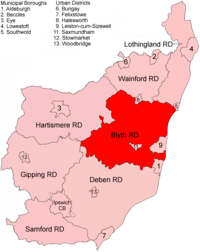Blyth Rural District
Blyth Rural District was a rural district in East Suffolk, England, between 1934 and 1974.
| Blyth | |
|---|---|
 Location within East Suffolk, 1934 | |
| History | |
| • Created | 1934 |
| • Abolished | 1974 |
| • Succeeded by | Suffolk Coastal |
| Status | Rural district |
The rural district was formed by the merger of parts of Blything Rural District and Plomesgate Rural District with a small parts of Hoxne RD, all of which were being abolished.[1] It covered a coastal area north of Aldeburgh and inland parishes around Saxmundham.
The district was abolished in 1974 under the Local Government Act 1972, and became part of Suffolk Coastal district.
Statistics
| Year | Area[2] | Population [3] |
Density (pop/ha) | |
|---|---|---|---|---|
| acres | ha | |||
| 1951 | 98,184 | 39,734 | 19,281 | 0.49 |
| 1961 | 98,182 | 39,733 | 18,600 | 0.47 |
Parishes
Parishes formerly in Blything RD: Blythburgh, Bramfield, Chediston, Cookley, Cratfield, Darsham, Dunwich, Heveningham, Huntingfield, Kelsale cum Carlton, Knodishall, Linstead Magna, Linstead Parva, Middleton, Peasenhall, Sibton, Theberton, Thorington, Ubbeston, Walberswick, Walpole, Wenhaston, Westleton, Yoxford.
Formerly in Plomesgate RD: Benhall, Brandeston, Bruisyard, Cransford, Earl Soham, Easton, Farnham, Framlingham, Friston, Great Glemham, Hacheston, Kettleburgh, Little Glemham, Marlesford, Parham, Rendham, Snape, Sternfield, Stratford St Andrew, Swefling.
Formerly in Hoxne RD: Badingham, Dennington, Saxtead.
References
- "Blyth RD through time: Census tables with data for the Local Government District". A Vision of Britain through Time. GB Historical GIS / University of Portsmouth. Retrieved 10 July 2017.
- "Blyth RD through time: Population Statistics: Area (acres)". A Vision of Britain through Time. GB Historical GIS / University of Portsmouth. Retrieved 10 July 2017.
- "Blyth RD through time: Population Statistics: Total Population". A Vision of Britain through Time. GB Historical GIS / University of Portsmouth. Retrieved 10 July 2017.